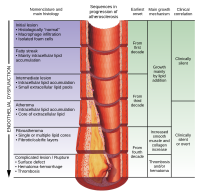
Photo from wikipedia
Objectives Suboptimal diet is the leading cause of cardiovascular disease (CVD) and is implicated in the etiology of vascular dysfunction. Arterial stiffness is a pathological vascular change that is associated… Click to show full abstract
Objectives Suboptimal diet is the leading cause of cardiovascular disease (CVD) and is implicated in the etiology of vascular dysfunction. Arterial stiffness is a pathological vascular change that is associated with higher subsequent risk of CVD. This study aims to investigate the cross-sectional association between diet quality and arterial stiffness, as assessed by brachial-ankle pulse wave velocity (baPWV). Methods Data from the Kailuan Study, a prospective cohort from China, were utilized for these analyses. Baseline data from subjects who were free of CVD were included (n = 22,563). Dietary intake was assessed by a semi-quantitative validated food frequency questionnaire. Diet quality was quantified using the American Heart Association diet score (range 0 to 5), which is based on the consumption of fruits/vegetables, fish, sodium, sweets/sugar-sweetened beverages, and whole grains. Participants were categorized into three groups based on their diet quality: poor (0-1), intermediate (2-3), and ideal quality (4-5). Participants also had baPWV measured. General linear models were used to calculate adjusted means with 95% confidence intervals (95% CI) for baPWV across diet quality groups, after adjusting for age, sex, BMI, education level, smoking status, blood pressure, fasting blood glucose, LDL cholesterol, and HDL cholesterol. Logistic regression analysis was used to estimate the odds ratios for arterial stiffness (baPWV ≥ 1400 cm/s) across diet quality categories. Results Greater diet quality was associated with lower baPWV values (P-trend < 0.001). Adjusted mean baPWV was 1436 cm/s (95% CI: 1417-1454), 1428 cm/s (95% CI: 1408-1447), and 1397 cm/s (95% CI: 1365-1430) for poor, intermediate, and ideal diet quality, respectively. We observed a non-significant inverse trend between diet quality and odds of having arterial stiffness (adjusted OR between two extreme groups = 0.81, 95% CI: 0.61-1.07, P trend = 0.11). Conclusions In this cross-sectional analysis greater diet quality was associated with lower baPWV values in individuals without CVD. Funding Sources The start-up grant from the college of health and human development and the department of nutritional sciences, Penn State University and the Institute for CyberScience Seed Grant Program, Penn State University.
Journal Title: Current developments in nutrition
Year Published: 2019
Link to full text (if available)
Share on Social Media: Sign Up to like & get
recommendations!